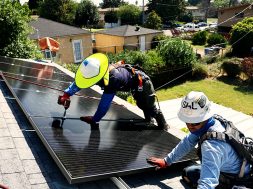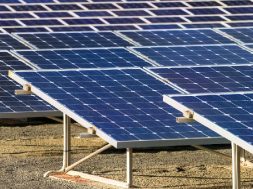
C’GARH AMONG 15 STATES SUPPORTING ROOFTOP SOLAR GRID SYSTEM
Chhattisgarh is among 15 States, namely, Andhra Pradesh, Chhattisgarh, Gujarat, Haryana, Himachal Pradesh, Karnataka, Kerala, Manipur, Punjab, Rajasthan, Tamil Nadu, Telangana, Uttar Pradesh, Uttarakhand and West Bengal which have come out with a solar policy supporting grid-connected rooftop systems, the Central Government has informed.
Recently, the Reserve Bank of India (RBI) had included renewable energy projects under priority sector lending for which bank loans up to a limit of Rs 15 crore to borrowers will be available for renewable energy projects including grid connected solar rooftop and ground mounted systems. For individual households, the loan limit is Rs. 10 lakh per borrower, it informed.
Department of Financial Services has advised all Public Sector Banks to provide loans for grid connected rooftop solar systems as home loan/ home improvement loan.
So far, ten PSBs namely Bank of India, Syndicate Bank, State Bank of India, Dena Bank, Central Bank of India, Punjab National Bank, Allahabad Bank, Indian Bank, Indian Overseas Bank and State Bank of Bikaner & Jaipur have given instructions to their branches.
The Chhattisgarh Renewable Energy Development Agency (CREDA) will be installing Grid Connected Solar Photovoltaic Power Plant in seven locations of the State.
The SPV plants would be would be installed at District Hospital, Bijapur, Bastar, PWD Head office building, Naya Raipur, District Panchayat, BIjapur, Bastar, Power Grid Corporation of India Ltd, at Bharari in Bilaspur, Govt. Digvijay College, Rajnandgaon, Indira Art & Music University, Khairagarh, Rajnandgaon district and CSPSCL Training Institute, Gudhiyari, Raipur, officials informed.
Notably, Chhattisgarh will procure additional power from renewable energy sources to the tune of approximately 700 MW by FY 2018, officials informed.
With this the average power purchase cost for Chhattisgarh State Power Distribution Company Ltd (CSPDCL) based on the above power availability will increase from 2.58 Rs/kWh in FY 2015-16 to 3.12 Rs/kWh in FY 2018, they informed.
The rates have been derived based on cost of power at existing rates and considering no escalation in power purchase cost since it is passing through for the distribution company.
Notably, CREDA has invested Rs 400 crores during last 11 years in developing infrastructure for solar power generation which had resulted in 40 MW of electricity being generated from non conventional energy sources.
The agency will be installing a total of 10,000 submersible and surface solar photo voltaic (SPV) irrigation pumps in farm lands soon across the State.
The SPV Pumps shall be provided with lightening and over voltage protection. The principal aim in this protection is to reduce the over voltage to a tolerable value before it reaches the PV or other sub-systems components. The source of over voltage can be lightening or any other atmospheric disturbance, officials informed.
Notably, the State government has already commenced preparation for setting up 51,000 solar powered irrigation pumps in a span of two-and-half-years in the State.
The government has set the target of setting up 11,000 solar pumps in the current financial year till March 2017 and the rest during the next two years.
Notably, Chhattisgarh government is also planning to add 2640 MW of additional renewable energy capacity by financial year 2018-19, officials informed.
The State currently has total renewable energy potential of 4,500 MW which includes solar (grid connected and roof top), wind biomass and small hydro.
The State has also planned to install solar powered pump sets for agriculture consumers which will benefit 16,000 consumers.
It may be recalled that there are significantly more number of villages which are to be electrified in Chhattisgarh using the off-grid (solar) mode than the grid-based (conventional power supply.
The State will soon also launch a ‘Solar Community Irrigation Project’ for drawing water extracted using solar pumps for supplying to the agricultural land of farmers across the State.
A total of 19 remote villages have been approved for creation of solar ‘mini grids’ to provide them access to power supply as on February 2017 in Chhattisgarh, the Central Government has informed.
Village mini-grids are important components of universal access to electricity in the country particularly for those villages where grid connectivity is either not feasible or not cost effective, it informed.
Under the RGGVY scheme launched by the Central government for attainment of goal of providing access to electricity to all households, a provision of Rs 540 crore has been kept as subsidy requirement for electrification of villages where grid connectivity is either not feasible or not cost effective for Decentralized Distributed Generation (DDG) during 11th Plan period.
DDG may be from conventional or renewable or non-conventional sources such as biomass, bio fuel, bio gas, mini hydro, geo thermal, solar, etc.
The funding is on the pattern of 90% subsidy from Government of India and 10% loan from Rural Electrification Corporation (REC) or from own funds of the state/loan from financial institutions.
In a separate scheme, the Union Ministry of New and Renewable Energy (MNRE) provides a subsidy of 30% of project cost subject to a maximum of Rs.150/- per watt peak for installation of stand alone rural Solar Photo Voltaic (SPV) power plants with battery storage in a micro grid mode/local distribution network under the Off-grid Solar Applications Scheme of Jawaharlal Nehru National Solar Mission.
This scheme is open to all the States and Union Territories. So far, one project of 20 kWp capacity standalone SPV micro grid project has been installed in the State of Jharkhand.
MNRE has released an amount of Rs.30 lakh during 2009-10 for a 20 kWp stand-alone SPV power project at Jhargram village in Gumla district in Jharkhand. Rs.50 lakh and Rs.53 lakh were released during 2010-11 and 2011-12 respectively for a stand-alone SPV power plant in Village Jari, Gumla district in Jharkhand. During 2011-12, MNRE has sanctioned 533 kWp for SPV micro grid projects in the States of Uttar Pradesh(U.P) and West Bengal. An amount of Rs.45 lakh has been released for projects in UP.
The Central Government has approved 11.2 MWp of power generation capacity from grid connected roof-top solar power plants in Chhattisgarh as on January 31, 2017.
Nationally, an amount of Rs 600 crore has been allocated for the projects under “Grid Connected Rooftop and Small Solar power Plants Programme” and Rs. 508.84 Crore has been released as on the aforesaid period, the Central Government has informed.
The Ministry of New & Renewable Energy (MNRE) has been promoting “Grid Connected Rooftop and Small Solar Power Plants Programme” with a Central Financial Assistance (CFA) of upto 30% of benchmark cost in General category States and up to 70 % in Special Category States, North Eastern States, Lakshadweep, Andaman & Nicobar Islands. Residential, Institutional and Social sector are covered under this CFA pattern.
For Government Sector, achievement linked incentive up to Rs 18750/kWp in General Category States and Rs.45000/kWp in Special Category States , North Eastern States and Andaman & Nicobar Islands and Lakshadweep is available under the Programme, it informed.
The Union Ministry of New and Renewable Energy (MNRE) has launched a pilot scheme for promotion of large scale grid-connected roof-top solar PV projects in Raipur city, officials informed.
The Raipur Smart City Ltd (RSCL) is to implement the project in city.
The generated solar power may be utilized for captive application and the surplus power may be fed to the grid. The scheme aims to reduce the fossil fuel based electricity and make buildings self-sustainable from the point of electricity, to the extent possible.
This scheme with aggregate capacity of 2155 kWp in various states across the country envisages installation of grid-connected roof top solar PV projects on the roofs of entities as specified by MNRE.
Notably the Chhattisgarh Government will implement 21,255 Kw grid connected solar PV system scheme for Government buildings located in Raipur city under Renewable Energy Service Company (RESCO) model.
A total of 159 Government schools in Chhattisgarh were using solarenergy to meet their power supply requirements during the last financial year (2016-17), officials informed.
The State currently also has total renewable energy potential of 4,500 MW which includes solar (grid connected and roof top), wind biomass and small hydro, they informed.
It has also planned to install solar powered pump sets for agriculture consumers which will benefit 16,000 consumers.
It may be recalled that there are significantly more number of villages which are to be electrified in Chhattisgarh using the off-grid (solar) mode than the grid-based (conventional power supply.
The State has also launched a ‘Solar Community Irrigation Project’ for drawing water extracted using solar pumps for supplying to the agricultural land of farmers across the State.
The Central government has released Rs 12 lakh each for Raipur and Bilaspur for the Solar City project, officials informed. The total sanctioned funds for the two cities is Rs 43 lakh each. A total amount of Rs. 67.01 crore has been sanctioned for preparation of master plans, solar city cells, promotional activities and installation of renewable energy projects and an amount of Rs. 24.16 crore has been released, so far, under Solar City Programme. Out of 7 identified solar cities in Maharashtra, an amount of Rs. 7.74 crore has been sanctioned and an amount of Rs. 3.04 crore has been released for 6 solar cities.
Notably , Chhattisgarh will procure additional power from renewable energy sources to the tune of approximately 700 MW by FY 2018, officials informed. With this, the average power purchase cost for Chhattisgarh State Power Distribution Company Ltd (CSPDCL) based on the above power availability will increase from 2.58 Rs/kWh in FY 2015-16 to 3.12 Rs/kWh in FY 2018, they informed. The rates have been derived based on cost of power at existing rates and considering no escalation in power purchase cost since it is passing through for the distribution company















